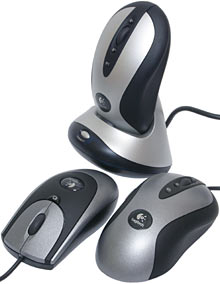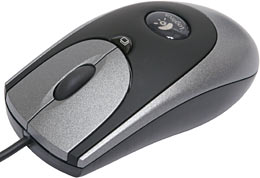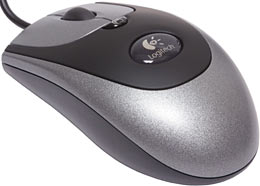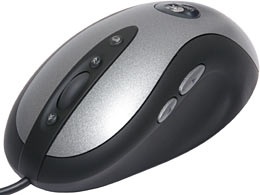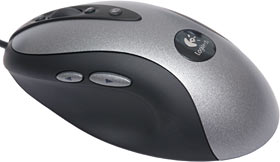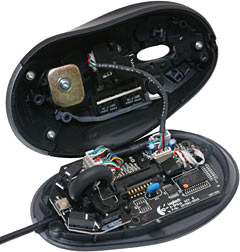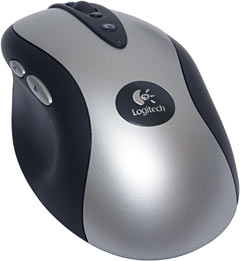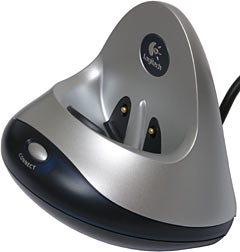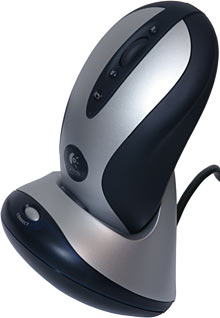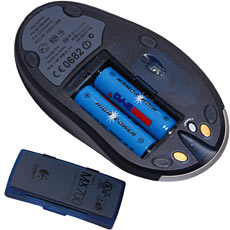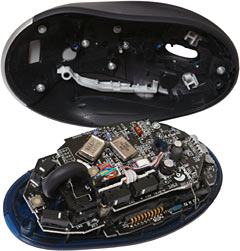
Logitech MX 300, MX 500 and MX 700 mouses
Review date: 23 November 2002.Last modified 03-Dec-2011.
Logitech's new MX-series mouses are, according to Logitech, very exciting and innovative.
They are, according to me, quite nice.
But the last really significant step forward in PC mouse technology is now more than three years old.
The original Microsoft "IntelliEye" mouses (or mice, or meeces, as you please; I call 'em mouses, and you ain't gonna stop me) came out in 1999. I reviewed a couple of them in that year, here. The Hewlett-Packard technology they used has been improved since, but the basic idea's the same; a little camera peers out of the bottom of the mouse at whatever you're moving it over; the red light they all have underneath them is an LED that obliquely illuminates the surface to bring out its detail. Digital Signal Processing hardware built into the mouse detects what direction the surface under the mouse seems to be moving in, and translates that information into cursor movement. No ball, no moving parts, nothing to gum up or wear out.
Before 1999, all "optical" mouses needed a special mousepad to work (well, they needed one to work well; the ones with non-reflective mats would generally kind of work on a newspaper photo). Nowadays, "optical mouse" means "all-surface optical mouse", and you can use them on your desk, on your leg, on your carpet; no problem.
Newer opticals have higher camera imaging rates, allowing them to be whipped around faster; they generally have higher resolution, too, giving them more counts-per-inch, so you still have fine control even when the mouse speed's set high. But the basic idea's the same, and an original-generation all-surface optical mouse is likely to be quite good enough for most users.
This, of course, is bad news for the mouse companies. Suddenly, they're making products that don't wear out. The little feet on the bottom may scuff up and the cable may eventually fail, but otherwise, opticals last forever, with no maintenance, unless you manage to get a pizza crumb stuck over the lens.
It's hard to sell everybody a new mouse every year if the things don't wear out.
Hence, shiny new models.
Logitech's MX-series mouses are their shiny new models, but they're, fortunately, not just last year's mouse in a new wrapper.
Electronically, I'm unconvinced that there's anything very special about them, though.
The sensor in the MX-series mouses is grandly named the "MX Optical Engine", and Logitech proudly claim that it captures "up to 4.7 megapixels of surface tracking information every second". Which is apparently more than any previous mouse sensor manages. But Logitech have stopped quoting how many images of the surface the mouse snaps per second, and nobody ever seems to have quoted the actual sensor resolution of one of these things. So I'm in the dark about what, if anything, the megapixel number means.
If you assume the MX mouses have the same 6000-shot-per-second imaging rate as the Microsoft IntelliMouse Explorer 3.0 - I'm guessing that if they were any better, Logitech would have said so - then "up to 4.7 megapixels per second" means "783 pixels per image, at most", or "a sensor that's 28 pixels square". The fact that doing the sums from 4.7 million pixels gives 27.98 pixels as the height and width of the sensor suggests to me that this actually could be a 28 by 28 pixel sensor, but that doesn't explain the "up to" part, and I'm really just guessing.
It hardly matters, anyway; the sensors in the MX mouses just need to be as good as the sensors in the v3.0 Microsoft mouses (I checked the IntelliMouse Explorer 3.0 out a year ago, here), which work on pretty much any surface, and track more than fast enough to deal with very twitchy twitch-game players. And they seem to be. That'll do.
UPDATE: According to Tom's Hardware, these things have a 30 by 30 pixel sensor with a 5250Hz sample rate. So there you go.
There are three MX mouses, the MX 300, MX 500 and MX 700. The 300's the basic model, the 500's got extra buttons and swoopy design, and the 700's is probably the best cordless mouse that's yet been made. Provided you're right handed.
The US list prices for the 300, 500 and 700 are $US29.95, $US49.95, and $US79.95, respectively. US residents can buy them direct from Logitech, and many other dealers also stock them, of course. Here in Australia, the 500's available now, and the 300 and 700 should be along shortly.
Which, if any, is right for you?
Glad you asked.
The MX 300
The basic MX mouse is the only one that's useable by left handed people. The 500 and 700 can be used by a lefty in a pinch, but they've got a thumb groove and two buttons on the left side, and there's no way to hold them comfortably in your left hand.
The MX 300, though, has something close to Logitech's basic symmetrical mouse shape; it's very close in shape to their classic First Mouse Plus. It should be comfortable for people with a wide range of hand sizes.
This is a four button mouse. It's got two normal buttons, a clickable wheel (clicking the wheel down is button three), and another little "quick-switch" button in the middle, behind the main buttons.
The quick-switch button is so named because its default behaviour, in Windows, is to open up an Alt-Tab-ish icon list of all the windows you've currently got open, so you can click one to choose it. Quick-switch takes up more screen space than the regular Alt-Tab interface, which allows it to show you full window titles, but it's not exactly a must-have feature.
The good news is that Logitech's "MouseWare" driver software, which supports pretty much every mouse they've ever made, allows you to reconfigure the quick-switch button to do something else. Various Windows-y functions and function keys, some more useful than others, can be bound arbitrarily to any mouse button you want. There are the usual cutesy Web navigation features, super-fast scrolling, blah blah blah, plus prosaic F-key emulation, and such.
The bad news is that either Logitech's software team are, and have always been, about as sharp as a sack of wet mice, or there's some nasty Microsoft-monopoly hidden-function feature of Windows that precludes Logitech from making driver software that works as well as Microsoft's IntelliPoint.
MouseWare, you see, can be... quirky... in regular Windows applications, and downright annoying for games.
All three of the MX-series mouses, like other MouseWare-afflicted products I've seen, had weird scroll-wheel behaviour when MouseWare was running. The best I saw from them was uneven, lumpy scrolling - turn the wheel several steps, and watch the screen scroll a bit, then a lot, then a bit again. In Internet Explorer, the MXs were unable to scroll more than about eight steps per second, which meant twirling the wheel with gusto could leave you waiting for (what seemed like) an age for the page to march up the window and get to the point you ordered.
And, worst still, single scroll steps are occasionally ignored completely; when you step the scroll wheel again, you get two steps in one go. Commonly enough, particularly with the MX 300 for some reason, I saw triple step behaviour, where two steps were ignored and then three came all at once. Eeeew.
Quit out of MouseWare (easy to do, when you realise that its name in the Windows process list is "EM_EXEC", and just kill the task), and suddenly the Logitech mouses' scroll behaviour is immaculate. There doesn't seem to be anything wrong with the MX mouse hardware; MouseWare just gets in the way untidily between that hardware and Windows. It is alleged that a better version of MouseWare will be out Real Soon Now. I'll believe it when I see it.
The workaround to let you use the scroll wheel properly without quitting MouseWare isn't too complex; you just set the wheel in MouseWare to scroll zero lines per click, and then use Tweak UI (available for Win95 to Win2000 here, and for WinXP here), go to the Mouse settings, and turn on the "Use mouse wheel for scrolling" option.
Oh, yes. Games.
Run MouseWare by itself (without using the abovementioned Tweak UI workaround) and there's a good chance that you won't be able to use any recent Logitech mouse's extra buttons, or even its scroll wheel, in games. They just won't show up at all, or they'll be an "unknown keycode", or something. You can probably get the wheel working by using Tweak UI, but MouseWare seems likely to still block the buttons. It did for me.
Logitech know about this problem, and have for a while now offered a link to a "game_whl" registry patch (described as "Mouse Registry File for GAMERS"; get it direct here), on their MouseWare download pages. The patch is supposed to be for Windows 95, 98 and NT only, but people running newer Windows flavours have reported that it works.
Well, it didn't for me. No joy on the extra buttons or wheel in games, until I just killed MouseWare manually. Then everything worked, except for the quick-switch button.
So, for games, I think you'll find the MX 300 behaves as a regular two-buttons-plus-wheel mouse. Which is no bad thing, but not terribly exciting.
Logitech's claims about the very high resolution of the MX series mouses, though, appear to be justified. Even with mouse speed wound up to maximum, these mouses let you move the cursor one pixel at a time.
What's this good for?
Sniping.
Not much else.
It doesn't hurt to have pixel-by-pixel mouse resolution, and I suppose there might be some small useability gain to be had from a cursor that moves in one pixel steps rather than two or three pixel steps; visual input feedback and all that stuff. But for most applications, you don't need it.
Office apps don't need mouse resolution greatly smaller than the size of the smallest thing you'll be aiming at - probably a text character. People using graphics programs often do pixel-by-pixel work - but unless you're some kind of freak, you do it with the magnification turned up. Never mind the mouse resolution, you probably don't have sufficient hand and eye resolution to do single-pixel work at 1X magnification.
Again, it sure doesn't hurt, and people who are doing photo retouching or CAD or whatever are certainly going to have more use for a super-resolution mouse than people who are doing word processing or spreadsheet work. But graphics nuts probably want a tablet, not any kind of mouse, and everyone else really can get along just fine with the resolution of any old mouse.
In games, though - especially 3D action games - you there's a use for high mouse speed and fine control. High mouse speed lets you turn around fast without having to move anything above your wrist; fine control lets you line up weapons on small targets, for those moments when the enemy's a speck in the distance, and chivalrous play is not on your agenda.
For that, the MX-series mouses are just the thing. Shame about MouseWare, but you can always kill it.
What do the MX 300's giblets look like?
Why, like this. There's a separate little circuit board in the lid of the mouse for the quick-switch key, but apart from that the MX 300 doesn't look particularly unusual inside.
There's a small metal weight screwed into the lid of the MX-300, to give it a bit more heft. Serious gaming nutters will be wanting to remove that, to give them less mouse-mass to flick around.
Getting inside the mouse to make that simple modification, by the way, is very pleasingly simple. The 300 is held together by only one screw, and that screw is not under one of the mouse feet, or even hidden under a sticker.
The actual pickup chip in the MX 300 (and 500) is covered by a plastic brace thing; removing the 300's brace revealed the chip to be another Agilent product (Agilent are what the HP division that developed the original all-surface-optical technology is now called) with "A2020" and "A0230" stamped on it. Those numbers don't match any product listed on the Agilent Semiconductor Products site (all Agilent seem to say about it on their site is this piece of puffery), but I don't presume the chip to be an ultra-hyper-special Logitech-only product.
Another by-the-way - all of the MX-series mouses are USB/PS2 compatible. They've got a USB plug on the end of their cable, but they come with an adapter to connect to PS/2. The adapter will only work with mouses that know, already, how to speak to both interfaces; don't expect to be able to use it to turn any USB mouse into a PS/2 one.
OK. On to the midrange model.
The MX 500
Logitech's stylists are at it again, and have managed to make the MX 500 and 700 (which are both the same shape) even more avant-garde looking than the previous top-end MouseMan models, such as the Dual Optical I compare with the IntelliMouse Explorer 3.0 here.
The MX 300 and 500 are possibly the sleekest mouses ever made, because their main buttons are seamless. One smooth piece of plastic bifurcates into the left and right button areas, with the wheel in the middle. This isn't technologically all that incredible - regular mouses have plastic button hinges, after all - but it does look very cool indeed. The buttons work very well; not too heavy, not too light.
The recent MouseMans (MouseMen?) had only one side button; the MX 500 and 700 catch back up with Microsoft, and give you two. The side buttons are easy to use, but not easy to press by accident, and they have the same basic large-rear, small-front layout as the IntelliMouse Explorers use. All four of the primary buttons, and the clickable wheel, feel great.
Less great-feeling, and less easy to reach, are the three further buttons the 500 and 700 sport. Two of them sit fore and aft of the wheel; they're small, but not terribly difficult to use. And then there's another quick-switch button, even further back along the mouse's spine and quite close to its topmost point.
Without MouseWare, the two buttons next to the wheel each do the same thing as a wheel-click in the appropriate direction, except you can hold them down to repeat the click. This is not very useful, but it's more useful than the quick-switch button, which again does nothing without MouseWare.
The side buttons, though, work fine without MouseWare; they're MOUSE4 and MOUSE5, and any game worth its salt should understand them, as should other assign-things-to-buttons software. In Windows, without MouseWare, they default to "Back" and "Forward", which are functions you might quite like. I prefer Page Up and Page Down bound to my side buttons, but to each his own.
If you want to tie extra functions to any or all of the buttons, MouseWare will do it for you, and probably mess up your games. But at least it's easy to manually quit the driver software if it irks you, and the patch doesn't work.
The MX 500 is held together by two screws, both of which hide under stickers - but the stickers are helpfully scored with little crosses to mark the screw points, so you don't have to press all over them with a fingernail to find the fasteners. Once again, you need peel off no feet. This is good.
Inside, the mouse layout is about as tidy as can be expected, considering all those buttons. The two side buttons and the quick-switch button have their switchgear attached to the lid. There's another little weight, too.
The MX 500 is a big mouse - it's about the same length as Microsoft's Explorer 3.0, but has more volume. Thanks to its slinky styling, though, it's very comfortable to hold, even for someone like me who's very used to the Explorer shape. If you've got very small hands then the MX 300 is likely to be more to your taste, but you don't have to be able to cover the whole area south of the MX 500's buttons with your palm to be able to use it comfortably.
Here in Australia, Aus PC Market sell the MX 500 for $AU126.50, delivered (Australian buyers can click here to order it). The older IntelliMouse Explorer 3.0 is only $AU99 delivered, and gives nothing away to the MX 500 in the ergonomics department. The 500 has those three extra top buttons, but they're only useful with MouseWare running. So which one's better for you, assuming you want either of them, depends on whether you do a lot of Windows work that could benefit from the extra buttons.
If you just want the funkier looking mouse, mind you, the Explorer fights a gallant rearguard with its glowing red tail-light, but really can't compete with the seamless Star Trek slickitude of the MX 500.
For real show-off power, of course, you've got to go cordless.
So let's check out the next MX.
The MX 700
Ergonomically identical to the MX 500, the 700 is heavier but feels otherwise the same.
The shape's the same, but the plastic's different; the MX 700's shinier than its cheaper cousin.
Cutting to the chase - the MX 700 is the first cordless mouse that I'd actually consider using.
One feature it has that I want is rechargeability. Cordless mouses need batteries, and most of them aren't rechargeable; changing batteries is a pain. The MX 700 comes with a pair of 1600 milliamp-hour AA nickel metal hydride cells (or, in geek-speak, 1600mAh AA NiMHs)...
...and its receiver doubles as a charger for them.
You just drop the mouse into the receiver, tail first, to charge it. Neat.
The receiver/charger comes with a wall-wart plugpack that you plug into a socket on the end of the receiver's cable to provide it with charging juice. This means you can charge your mouse without actually plugging it into a computer, which may be useful to you. There's a little green light on top of the mouse that tells you its charge state.
The reason why I'd use an MX 700, though, isn't its rechargeability; there are other rechargeable cordless mouses out there, and heck, there's nothing stopping you using an outboard charger and a couple of sets of NiMH cells, if you don't want to swap in new alkalines every few months.
No, the big deal about the MX 700, the thing which makes it unique among tail-less rodents, is its sample rate - how frequently the cursor position is updated. It's 125Hz (Hertz, samples per second). That's just as fast as the corded MX-series mouses, and just as fast as any other corded USB mouse.
Most cordless mouses have a miserable sample rate. Microsoft's Wireless IntelliMouse Explorer, for instance (reviewed here), seems to have a sample rate of about 35Hz. That's about as bad as a serial mouse, and serial mouses are bad.
Gamers care a lot about this stuff - there's not a lot of point to having 120 frames per second of video competing for your attention if your mouse only changes your aim 35 times a second. But sample rate matters for more practical applications as well, because low-sample-rate mouses feel nasty to use. Steppy. Uneven. You can see the cursor skipping across the screen.
Macintosh users, who've always had high sample rate mouses, suffer fits of revulsion if confronted with slow PC mouses.
But the MX 700, uniquely among cordless mouses so far, is smooth and speedy.
Underneath, the MX 700 has an offset sensor, to accommodate its battery bay. This means it tracks slightly differently from the MX 500, but the difference is subtle and quite easy to get used to.
The removable battery door lets you exchange the MX 700's batteries if you want, but most people will have no need to, possibly for years.
The MX 700 is held together by two screws (one in the battery bay, one under another cross-scored sticker), and doesn't need any metal weights to bulk it up. The batteries and extra electronics give the 700 a weight of about 174 grams, versus about 128 grams for the MX 500 plus a few inches of its cable.
If you're a gamer who's been waiting for a cordless mouse that won't disgust you, the MX 700 is that mouse. Go and buy one, remember to quit MouseWare before you run your games (or just don't install MouseWare in the first place), and enjoy.
If a cordless mouse appeals to you for other reasons, though - for controlling your lounge-room or business-presentation PC from across the room, for instance, or just because you hate cables - then the MX 700 isn't a budget priced option, but it's a sleek, stylish, well-made one that works well, given the abovementioned MouseWare limitations. In my office, its useful range is about three metres from the receiver, which is more than enough for many purposes; you may be able to manage better, if you're somewhere less riddled with radio frequency interference than my computer-infested environs.
Overall
The MX series mouses aren't dirt cheap, and their software could be better, but you can work around the problems, and they're otherwise great.
The MX 300 is a cheap super-high-resolution optical that looks nice and is left-hander-friendly; despite its extra button being useless in games (with the current software, anyway), it's a decent piece of gear for the money.
The MX 500 is worthy competition for the IntelliMouse Explorer 3.0. It looks better, it's got better resolution, it feels very nice, and it's got just as many buttons for games, and even more for Windows stuff. It costs more, yes, but you can't have everything.
The MX 700 is, as I mentioned above, the first cordless mouse that'll suit gamers. Well, gamers who don't mind its not inconsiderable weight, anyway. Personally, I'm not crazy for cordless mouses, but lots of people like them, and some of those people actually have practical reasons to own one. Once again, provided MouseWare's personality quirks don't turn you off, this is a good product, though not a terribly cheap one.
What mouse am I using? The same Explorer 3.0 I've been using for a year, thank you.
Partly because I'm used to the shape, partly because it still works fine (older Explorer models tended to suffer cable breakage problems, but this one's just got a somewhat looser scroll wheel than it had when new), and partly because Microsoft's mouse software doesn't stick its thumbs up its nose (a technical term) when you run games.
The Explorer 3.0 looks positively dowdy next to the MX 500 and 700, though, and their beauty is more than skin deep. Check 'em out.
Buy stuff!
Aus PC Market don't sell the MX-series mice, mouses
or meeses any more, but their mouse
lineup of course includes all of Logitech's current products, including the
G5, which
replaces the MX500.
(if you're not in Australia or New Zealand,
Aus PC Market won't deliver to you. If you're in the USA, try a price search
at
DealTime!)
